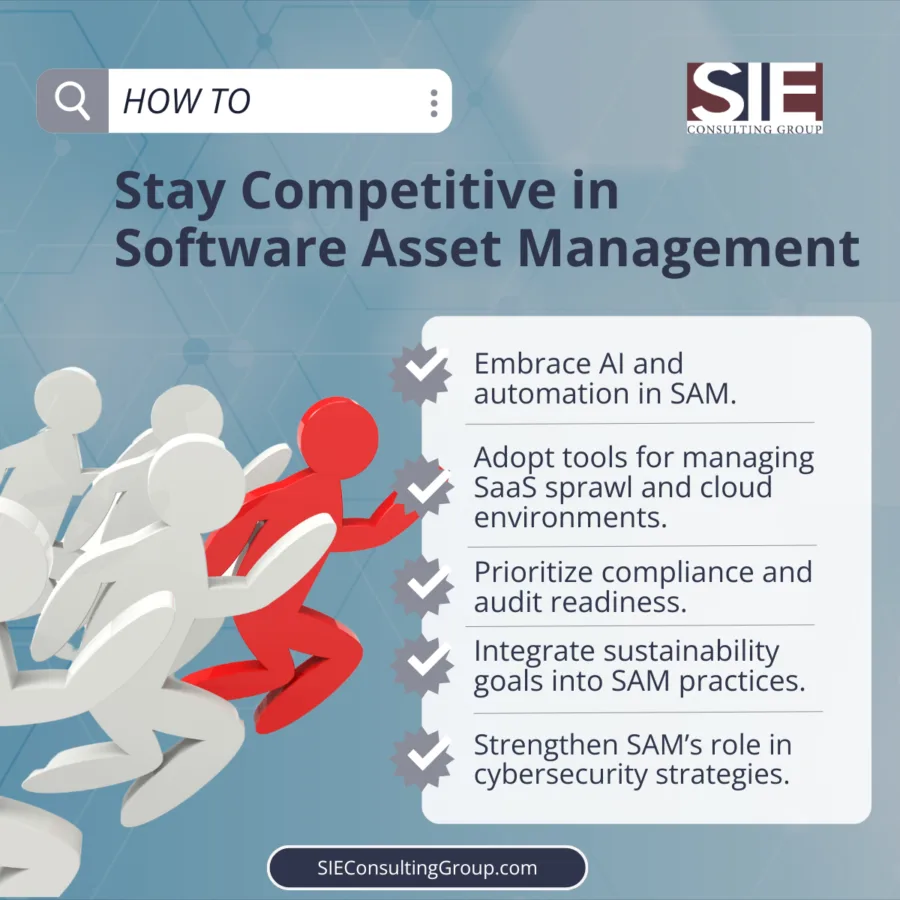The SAM landscape is being shaped by AI advancements, cloud complexities, heightened compliance requirements, and organizational sustainability. The best businesses will proactively adapt to these trends, and optimize their software assets, control costs, and mitigate risks.
As digital transformation accelerates across industries, the importance of Software Asset Management (SAM) has never been more critical. SAM enables organizations to effectively manage, monitor, and optimize their software assets, ensuring compliance and cost-efficiency in increasingly complex IT environments.
For the rest of 2025, we expect technological advancements and industry shifts are set to redefine the SAM landscape, offering opportunities for innovation while presenting new challenges.
1. Rise of Automation and AI in SAM
Artificial Intelligence (AI) and automation are revolutionizing SAM processes, making them smarter, faster, and more accurate. With software and cloud ecosystems becoming more complex, AI-driven tools are emerging as a solution for asset discovery, compliance checks, and license optimization.
AI-powered SAM platforms will deliver predictive insights into software usage patterns, accurately forecast licensing needs, and identify cost-saving opportunities. Automation will alleviate administrative burdens, enabling SAM teams to focus on strategic tasks, such as vendor negotiations and IT procurement planning.
Key Takeaway: Businesses should explore AI-driven SAM tools to enhance efficiency, predict licensing requirements, and minimize compliance risks.
2. Managing SaaS Sprawl and Multi-Cloud Environments
The adoption of cloud computing and Software-as-a-Service (SaaS) models has skyrocketed, leading to "SaaS sprawl"—the uncontrolled accumulation of software subscriptions across departments. This often results in overspending and compliance challenges.
In 2025, organizations will increasingly adopt cloud management tools that provide unified visibility into SaaS and multi-cloud usage. Integrating SAM with cloud financial management (FinOps) practices will become essential for aligning software spending with business objectives.
Key Takeaway: Expect SAM platforms to expand and market features that optimize SaaS usage and support multi-cloud environments.
3. Increased Vendor Audits and Compliance
Software vendors, including Microsoft, Broadcom, IBM, ServiceNow, and Oracle, are intensifying audit activities to enforce licensing agreements, particularly within hybrid cloud environments.
SAM will play a pivotal role in audit preparedness by maintaining accurate records of software usage, licenses, and entitlements. This year, advanced SAM tools will emphasize real-time compliance monitoring and audit reporting capabilities, helping organizations mitigate risks and avoid penalties.
Key Takeaway: Proactively utilize SAM solutions with robust compliance features to strengthen your audit defense strategy.
4. Sustainability and Green IT Initiatives
As sustainability becomes a priority for organizations worldwide, SAM is evolving to align with environmental goals. Businesses are focusing on reducing IT asset and software waste, extending license lifecycles, and adopting energy-efficient practices in cloud operations.
Strategies like "license recycling"—reclaiming and reallocating unused licenses—will gain prominence in the right markets. SAM teams will increasingly collaborate with sustainability officers to integrate SAM practices into broader organizational goals.
Key Takeaway: Optimizing software usage through ITAM and SAM contributes to both cost savings and environmental responsibility.
5. Security and SAM Integration
Cybersecurity threats continue to grow, making SAM a vital component of an organization’s defense strategy. Managing software assets involves ensuring all applications are updated with current patches and vulnerability fixes. SAM hygiene includes removing unauthorized or outdated software from organizational networks.
This year, expect to see SAM tools integrate with cybersecurity platforms, offering real-time alerts on vulnerabilities and enhancing compliance with regulations such as General Data Protection Regulation (GDPR) and AI-focused legislation.
Key Takeaway: Leverage SAM solutions with integrated security features to bolster your organization’s risk management efforts.
